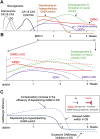Enhanced GIRK2 channel signaling in Down syndrome: A feasible role in the development of abnormal nascent neural circuits
- PMID: 36171878
- PMCID: PMC9510977
- DOI: 10.3389/fgene.2022.1006068
Enhanced GIRK2 channel signaling in Down syndrome: A feasible role in the development of abnormal nascent neural circuits
Abstract
The most distinctive feature of Down syndrome (DS) is moderate to severe cognitive impairment. Genetic, molecular, and neuronal mechanisms of this complex DS phenotype are currently under intensive investigation. It is becoming increasingly clear that the abnormalities arise from a combination of initial changes caused by triplication of genes on human chromosome 21 (HSA21) and later compensatory adaptations affecting multiple brain systems. Consequently, relatively mild initial cognitive deficits become pronounced with age. This pattern of changes suggests that one approach to improving cognitive function in DS is to target the earliest critical changes, the prevention of which can change the 'trajectory' of the brain development and reduce the destructive effects of the secondary alterations. Here, we review the experimental data on the role of KCNJ6 in DS-specific brain abnormalities, focusing on a putative role of this gene in the development of abnormal neural circuits in the hippocampus of genetic mouse models of DS. It is suggested that the prevention of these early abnormalities with pharmacological or genetic means can ameliorate cognitive impairment in DS.
Keywords: KCNJ6; depolarizing GABA; developmental GABA switch; early postnatal development; gabaergic neurotransmission; miR-155; neuronal excitability; synaptogenesis.
Copyright © 2022 Kleschevnikov.
Conflict of interest statement
The authors declare that the research was conducted in the absence of any commercial or financial relationships that could be construed as a potential conflict of interest.
Figures

Similar articles
-
GIRK2 Channels in Down Syndrome and Alzheimer's Disease.Curr Alzheimer Res. 2022;19(12):819-829. doi: 10.2174/1567205020666221223122110. Curr Alzheimer Res. 2022. PMID: 36567290
-
Evidence that increased Kcnj6 gene dose is necessary for deficits in behavior and dentate gyrus synaptic plasticity in the Ts65Dn mouse model of Down syndrome.Neurobiol Dis. 2017 Jul;103:1-10. doi: 10.1016/j.nbd.2017.03.009. Epub 2017 Mar 22. Neurobiol Dis. 2017. PMID: 28342823 Free PMC article.
-
Developmental excitatory-to-inhibitory GABA polarity switch is delayed in Ts65Dn mice, a genetic model of Down syndrome.Neurobiol Dis. 2018 Jul;115:1-8. doi: 10.1016/j.nbd.2018.03.005. Epub 2018 Mar 14. Neurobiol Dis. 2018. PMID: 29550538
-
The GABAergic Hypothesis for Cognitive Disabilities in Down Syndrome.Front Cell Neurosci. 2017 Mar 7;11:54. doi: 10.3389/fncel.2017.00054. eCollection 2017. Front Cell Neurosci. 2017. PMID: 28326014 Free PMC article. Review.
-
Mental retardation and associated neurological dysfunctions in Down syndrome: a consequence of dysregulation in critical chromosome 21 genes and associated molecular pathways.Eur J Paediatr Neurol. 2008 May;12(3):168-82. doi: 10.1016/j.ejpn.2007.08.010. Epub 2007 Oct 22. Eur J Paediatr Neurol. 2008. PMID: 17933568 Review.
Cited by
-
GIRK2 Channels in Down Syndrome and Alzheimer's Disease.Curr Alzheimer Res. 2022;19(12):819-829. doi: 10.2174/1567205020666221223122110. Curr Alzheimer Res. 2022. PMID: 36567290
-
Infantile Spasms in Pediatric Down Syndrome: Potential Mechanisms Driving Therapeutic Considerations.Children (Basel). 2024 Dec 13;11(12):1513. doi: 10.3390/children11121513. Children (Basel). 2024. PMID: 39767942 Free PMC article. Review.
-
Transcriptomic profiling across human serotonin neuron differentiation via the FEV reporter system.Stem Cell Res Ther. 2024 Apr 19;15(1):107. doi: 10.1186/s13287-024-03728-x. Stem Cell Res Ther. 2024. PMID: 38637896 Free PMC article.
References
-
- Altafaj X., Martin E. D., Ortiz-Abalia J., Valderrama A., Lao-Peregrin C., Dierssen M., et al. (2013). Normalization of Dyrk1A expression by AAV2/1-shDyrk1A attenuates hippocampal-dependent defects in the Ts65Dn mouse model of Down syndrome. Neurobiol. Dis. 52, 117–127. 10.1016/j.nbd.2012.11.017 - DOI - PubMed
Publication types
Grants and funding
LinkOut - more resources
Full Text Sources

